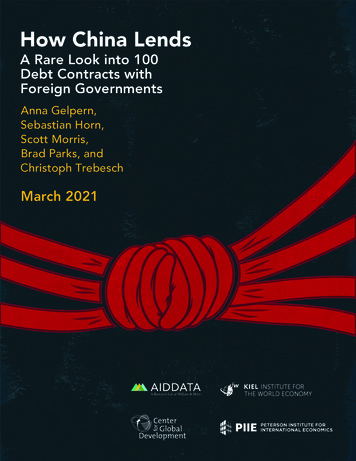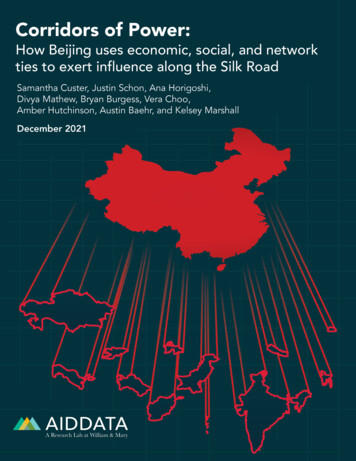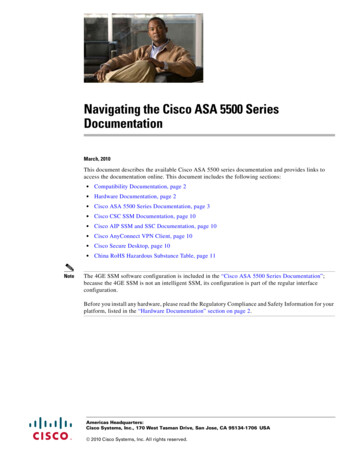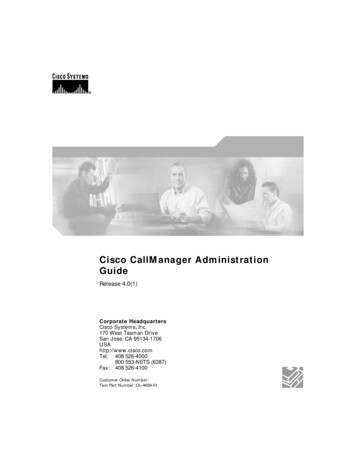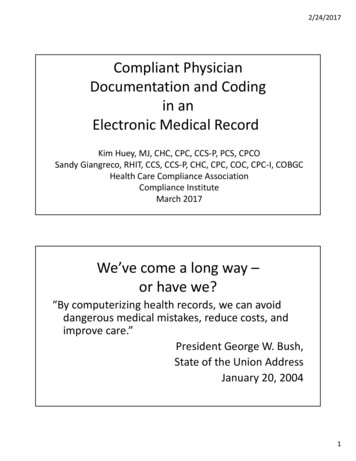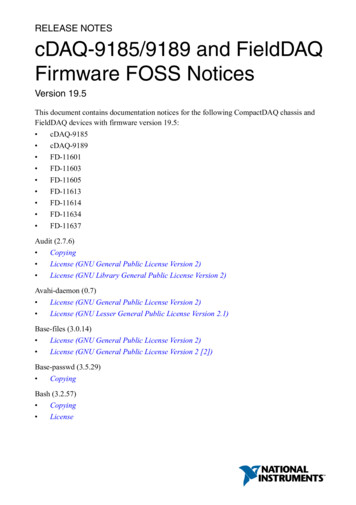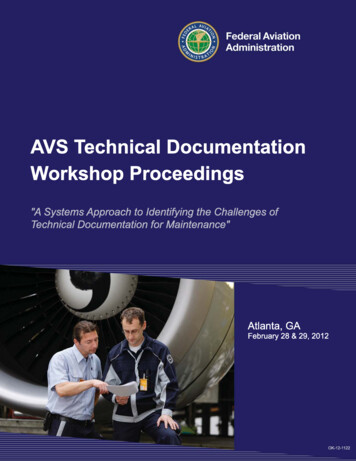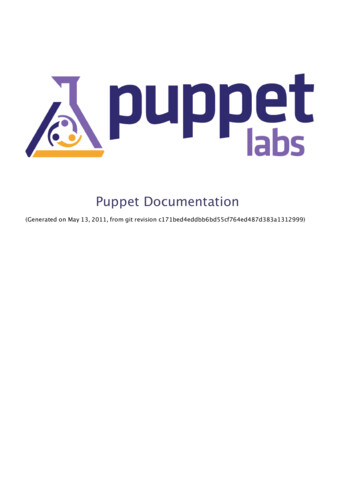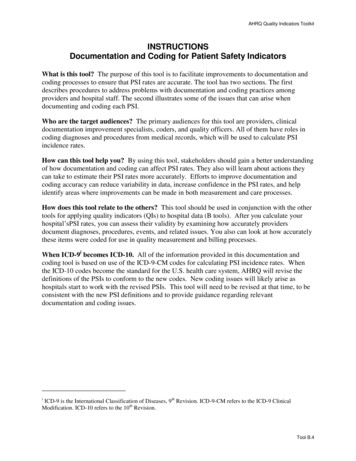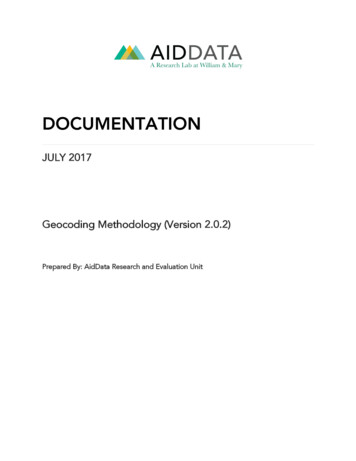
Transcription
DOCUMENTATIONJULY 2017Geocoding Methodology (Version 2.0.2)Prepared By: AidData Research and Evaluation Unit
AidData Geocoding Methodology (Version 2.0.2)Contents1. Introduction2. Roadmap for Geocodinga. AidData’s 4-Step Methodology3. Geocoded Data Products4. Location Type, Geographic Exactness and Precision Categoriesa. IATI Standardb. AidData Precision Codesc. The IATI-to-AidData Precision Crosswalk5. About the Geocoding Processa. Reviewing Project Information & Documentationb. Augmenting with Additional Sourcesc. Standardizing Location Information6. Basic Rules for Geocodinga. Finding Locationsb. Verifying Locationsc. Coding Pointsd. Coding Arease. Coding Lines7. Advanced Rules for Geocodinga. Locations with Ambiguous Namesb. Vague Area Referencesc. Unclear Locationsd. Cases with Clear Locations and Unclear Locations2
AidData Geocoding Methodology (Version 2.0.2)1. IntroductionThis codebook prescribes AidData’s method for geocoding foreign aid information and programmatic developmentdata that is made available through a wide range of donor, recipient, and other stakeholder-based sources. In broadterms, geocoding is a process by which an address is assigned a single data point with a corresponding latitude andlongitude. Georeferencing, not to be mistaken for geocoding, is a process in which an internal coordinate system ofa map, or a satellite/aerial image, is spatially referenced. Coders first “geoparse” through project documents toidentify information on sub-national locations. Next, they “georeference” this location information (finding thematching location on a map). Finally, they “geocode” said locations by assigning a specific latitude and longitudecoordinate. AidData’s Geocoding Methodology was initially derived from the UCDP Georeferenced Event Dataset(GED) Codebook version 1.0 (Sundberg et al., 20101), which covers the georeferencing of violent events. The UCDPsystem was adapted and complemented by additional protocols to enable the coding of aid projects, and has sincebeen updated to align with the internationally recognized best practices of the IATI standard (Strandow et al.,20112).The current AidData methodology allows for a hierarchy of location class through 4 unique classifications includingpopulated places, administrative boundaries, structures and topographical features. The specificity of the prescribedgeographic location is defined through an additional code for geographic exactness. Locations are coded to thelevel of subnational precision — what we describe as “granularity” — that the supporting documentationconfidently allows. Sources vary significantly in the quality of location information that is reported; in some cases theexact locations are named, and in other instances only a general area or a proximate location is provided. The mainobjective of the AidData methodology is to track all locations to which aid dollars are committed or disbursed.Locations that may be expected to benefit indirectly from development finance are not geocoded. The impliedmandate for this methodology is to “follow the money.”1Strandow, Daniel & Findley, Michael & Nielson, Daniel & Powell, Josh. (2011). The UCDP and AidData Codebook on Georeferencing Aid.Version 1.1.2Sundberg, Ralph & Mathilda Lindgren & Ausra Padskocimaite. (2010). UCDP Geo-referenced Event Dataset (GED) Codebook. Version1.0.3
AidData Geocoding Methodology (Version 2.0.2)2. Roadmap for GeocodingThe AidData geocoding methodology is designed to be flexible enough to accommodate project records from awide range of sources. Donor-sourced geocoding is referred to as a “top-down” process (e.g. World Bank Mappingfor Results), whereas recipient-sourced geocoding is referred to as a “bottom-up” process (e.g. Uganda AidManagement Platform). In the case of a “top-down” dataset, the geocoding process is typically single-sourced; alldocumentation is provided by the donor institution itself. There are some exceptions, as is the case with ourTracking Underreported Financial Flows (TUFF) geocoded datasets on development finance from non-traditionaldonors. These datasets are geocoded from open source documentation that is collected, curated, and standardizedby AidData. A “bottom-up” dataset is most commonly sourced from the recipient in the form of a standardized,multi-source Aid Information Management System (AIMS). AIMS are typically housed in the Ministry of Financeand/or Ministry of Planning within an aid recipient country. The records within these systems serve as the projectdocumentation used in a bottom-up geocoding process. For all source types, the time intensity of the codingprocess will vary significantly based on the quality and availability of project documentation.2.1 AidData’s 4-Step MethodologyFor a given project record, the geocoding process will typically include the following steps:1.Review basic project information and relevant documentation: coders are required to review the projecttitle, description, and all of the most current documentation3 available to ensure accurate locationinformation is accessed and recorded.2.Augment documentation with additional sources (optional): may include a cross-check with donor orrecipient databases as well as targeted web searches using project title, donor, recipient and/or uniqueproject ID.3.Code specified location(s):4.a.Identify correct location (must match name and location type described in the documentation)b.Apply appropriate location class and exactness codesc.Provide source name and URLd.Written notes with justification for the location including source page number, as well as a descriptionof third party documentation and references (if used). These notes are for internal use only and will notbe included in the final geocoded data product.e.Brief project description (optional) to be included in the final geocoded data product.Arbitration: reconciliation of two geocoded records (may be manual or automated)AidData’s geocoding methodology traditionally prescribes a “double-blind” approach to the geocoding process asa quality assurance (QA) measure. Each unique project record is assigned to two separate coding ResearchAssistants (RAs) without cooperation. The two geocoded records are then reconciled by a trained arbitrator to createone finalized project record be included in the raw dataset. In cases where the results of the two initial code roundsare identical, the project is automatically arbitrated and finalized.3As the priorities and geographic footprint of projects are subject to change over the course of implementation, geocoders are advised touse caution with regard to highly detailed subnational information available in antiquated documentation. Information derived from such sourcesmust be carefully evaluated to ensure their accuracy.4
AidData Geocoding Methodology (Version 2.0.2)3. Geocoded Data Products: Locating aid events in time andspaceThe data that has been produced under this coding scheme is compatible with a wide variety of data sources ondevelopment activities, including development results and indicator data, domestic budgets, and surveys. AidData’sgeocoded datasets are released as a suite of relational data products that capture aid projects and theircorresponding locations and transactions to allow users to configure the data in a way that is most appropriate totheir analysis.It is important to note that the unit of analysis for the financial component of the geocoded data is based on fundingcommitments as opposed to disbursed aid or calendar days (PLAID, 2010). Since data on the exact dates andlocations of funding disbursements is sparse, most geocoded projects can only be related to the year that a specificcommitment was made. With this in mind, AidData’s methodology will not capture commitment or disbursementamounts by location, as such granular financial information is rarely available. Transaction data can only bedescribed at the project level. The final geocoded data release will include a Transactions Table, where each rowrepresents an individual financial commitment for a given project. There is often a one-to-many relationshipbetween transactions and development projects, where a single project may consist of multiple transactions.Likewise, in many cases, a single development project is designed to reach multiple locations. This one-to-manyrelationship between development projects and their locations is addressed through the Projects Table andLocations Table within the geocoded data release. The projects table will provide a complete listing of all projectscovered in the dataset where each row represents a single project record. When aid projects are intended formultiple locations, we include an additional row of data in the locations table for each unique location for a givenproject record. Under this model, a locations table for our geocoded data will often include multiple rows for asingle development project.5
AidData Geocoding Methodology (Version 2.0.2)4. Location Type, Geographic Exactness and PrecisionCategories4.1 IATI StandardFor geocoded data to be useful for a wide range of applications, it is crucial to make it possible to select subsets ofthe data based on levels of granularity. To facilitate this, AidData has adopted the IATI standard for describing thelocation class and geographic exactness of a given geocoded location. Coders select one location code and oneexactness code for each location of a given project record. These fields are included in our geocoded datasets tohelp data users select portions of the data for analysis on the basis of their precision.IATI StandardLocation ClassGeographic Exactness1Administrative Regions (e.g. state,province, independent politicalentity)1Exact2Populated Place (e.g. city, village)2Approximate3Structure (e.g. building, bridge,road)4Other topographical feature (e.g.river, mountain, national park)The location class specification within the IATI standard disaggregates locations into 4 discrete categories tocategorize geographic features. The binary geographic exactness specification describes whether the geocodedlocation is the final expected destination of the financial flow, or an approximation based on the best availableinformation.AidData Use of Exact and Approximate MarkersThe use of the IATI geographic exactness specification may follow one of two distinct approaches (Method A andB). The first prescribes exactness on the basis of the geographic feature being coded, the second on the basis ofthe specificity of project documentation.Method A: An early iteration of AidData’s use of the exactness specification followed the first model. Locationswere coded on the basis of the presence of a clear geographic boundary. Under this model, populated placesand administrative divisions would always be coded as “exact” regardless of the nature of the project or availabledocumentation since the geographic boundary of these locations is fixed. The “approximate” code would beused only in rare cases where the geographic boundary of an area is contested or vague.Example A: For instance, a project aims to build 3 new schools in the district of Kigali. While the preciselocations of the schools are unknown, under Method A, the district of Kigali would be coded as exact, sincea district has a precise geographic boundary.6
AidData Geocoding Methodology (Version 2.0.2)Method B: In an effort to make the exactness specification more useful in analysis, we have opted to use thesecond model, where exact and approximate codes describe the precision of the location information provided.The “exact” specification will be used when the coder is confident that they have coded the end destination of afinancial flow. Flows that can only be traced to a general area or a proximate location will be coded as“approximate.”Example B: Under Method B, the same project described in Example A would take an approximate code,since the precise locations of the schools -- the true target locations -- are unknown.4.2 AidData Precision CodesPrior to the new IATI standard, AidData’s original geocoding methodology specified levels of granularity based onan eight-point precision code system. The first six categories were adapted from UCDP’s Geo-referencing ProjectCodebook (Sundberg et al., 2010), with only minor modifications to effectively capture development financelocations. Precision categories 7 and 8 were unique to the AidData Geocoding Methodology first introduced in theUCDP/AidData codebook (Strandow et al., 2011).AidData Precision System1The coordinates correspond to an exact location, such as a populated place or a physical structuresuch as a school or health center. This code may also used for locations that join other locations tocreate a line such as a road, power transmission line or railroad.2The location is mentioned in the source as being “near”, in the “area” of, or up to 25 km away from3The location is, or is analogous to, a second-order administrative division (ADM2), such as a district,4The location is, or is analogous to, a first-order administrative division (ADM1), such as a province,an exact location. The coordinates refer to that adjacent location.municipality or commune.state or governorate.The location can only be related to estimated coordinates (e.g. between populated places; along5rivers, roads and borders; or more than 25 km away from a specific location). Also used largetopographical features (greater than ADM1) such as National Parks which spans across severaladministrative boundaries.67The location can only be related to an independent political entity, but is expected to be disbursedlocally. This includes aid that is intended for country-wide projects as well as larger areas that cannotbe geo-referenced at a more precise level.The location is unclear. The country coordinates are entered to reflect that subnational informationis unavailable.**7
AidData Geocoding Methodology (Version 2.0.2)**This code was removed from the geocoding methodology in 2016. It will only appear in datasetspublished up to 2016.8The location can only be related to an independent political entity, but the central government willbe the only direct beneficiary (e.g. capacity building, budget support, technical assistance).4.3 The IATI-to-AidData Precision CrosswalkTo effectively accommodate the preferences of researchers while harmonizing with international standards for opendevelopment data, we retain AidData precision codes along with the IATI classification for location type andgeographic exactness in our geocoded data products. To achieve this, source data is geocoded based on the IATIsystem and then translated to AidData precision codes using an IATI-approved crosswalk between the two systems.IATI-Precision CrosswalkLocation ClassGeographic ExactnessPrecision Code2/3 1 12/3 2 21 1 31 1 44 2 51 1 61 2 88
AidData Geocoding Methodology (Version 2.0.2)5. About the Geocoding Process5.1 Reviewing Project Information & DocumentationEach aid project may have location information on several levels. First, a project title or brief description may containa clear location reference. For some datasets, these represent the sum total of available source information.However, these sources may not reflect comprehensive information on all of the intended target beneficiaries, or themost granular location information. After reviewing title and description for location information, projectdocumentation is assessed. As location information may be provided in more than one project document, codersare advised to employ reasonable due diligence and exhaust all possible current sources of information.If there is no direct mention of any location in the sources, and the title and abstract do not indicate that aid isgranted to the central government for the purpose of capacity building/technical assistance, aid is assumed to go tothe country in general. The country coordinates are coded with a location class of 1 for “Administrative Region” andan exactness code of 1 (corresponds to Precision Code 6). The data user should use their discretion to determine ifunclear aid locations coded at the national level should be included in their analysis.5.2 Augmenting with Additional SourcesIn this optional step, coders use established best practices and workspace-specific guidelines to identify additionalsources of location information. These searches tend to be most successful with rich project-level information,including but not limited to: unique project IDs, implementation timelines, and proper names of implementingpartners. Coders are required to furnish the urls to these sources and clearly identify the relationship between thenew source and the project record. Locations identified through external sources are authenticated through manualarbitration.5.3 Standardizing Location InformationThe AidData geocoding methodology derives coordinates for coded locations through the Geonames4 gazetteer.Geonames provides an online service, which contains names, administrative hierarchies and coordinates ofadministrative divisions, populated places, waterways, and other geographic features. The database currentlyconsists of over 10 million records, including 2.8 million populated places and over 5 million alternate locationnames. The latitude and longitude coordinates are recorded with a six decimal precision. The map projection usedis the standard World Geodetic System 1984 (WGS 84) (Sundberg et al, 2010). Coders may augment Geonameswith additional locations as needed if they are able to identify appropriate coordinates for a specified locationthrough Google Earth or other recognized secondary sources of geographic information. All new locations areadded to the Geonames database in the process of geocoding to maintain a stable record of all locationinformation.4http://www.geonames.org/v3/9
AidData Geocoding Methodology (Version 2.0.2)6. Basic Rules for Geocoding6.1 Finding LocationsOnce location information has been identified in the documentation, the coder will consult the Geonames gazetteervia AidData’s internal coding platform or Geonames.org to find a matching location record. If no exact matches areavailable within the correct country, coders will perform a “fuzzy” search to capture a broader range of locationmatches and alternate naming conventions. If the correct location is not currently available via Geonames, the codermay use other third party resources to identify appropriate coordinates. Third party resources may include GoogleEarth, Google Maps, Wikipedia (with appropriate references), and GADM.org (database of administrativeboundaries for countries all over the world). Once the correct location is identified, it is entered into the codinginterface along with the source information and notes to guide manual arbitration of the new location.6.2 Verifying LocationsMany place names are not unique, even within a specified country. For example, there are at least 35 uniquepopulated places called Washington within the United States. In cases such as these, a location name may not besufficient to identify the correct location. Coders must use additional information regarding the administrativeboundaries, location classification, and nearby landmarks to triangulate the correct location with confidence. Thisissue is covered in greater depth in Section 7.6.3 Coding PointsLocations such as cities and villages (Location Class 2), hills (Location Class 4), farms and buildings (Location Class 3)will be represented as a single point location. Geographic exactness will be specified on the basis of the projectactivity. If aid flows are expected to be disbursed in that precise location, the point is specified as exact. Geocoderswork to identify coordinates for the most granular location possible. However, coordinates for specific structures andbuildings are often scarce outside major landmarks such as government buildings, universities and hospitals inprimary cities. In cases where the coordinates for a given structure are unavailable, the correspondingcity/town/village is coded as approximate. Likewise, in cases where sources refer to a unit within an institution orstructure, such as a specific department within a university, the coder will use the most specific geographic pointavailable -- often the parent location. This is also true for intervention sites that may not be attached to a precisecoordinate pair (such as a microfinance community group) or would benefit a community as a whole or arefrequently impossible to locate (such as a borehole for fresh water). In these cases, the populated place may becoded as exact since it is the most granular known location.In cases where multiple components of a project are expected to be executed in the same location, the location isonly coded once for the whole project.Example: For instance, if there are funds going to farms somewhere in the location Bengo (location class 2), aswell as to support hospitals in the same area, then Bengo would be coded once as approximate with notes foreach component.Suburbs are borderline cases. Suburbs to cities should be considered to be locations in their own right and arecoded accordingly if the coordinates are available, even if the city itself is also coded. If the coordinates of a majorsuburb are not available, the city (location class 2) is specified as approximate.As a rule, if a point location cannot be identified via the search functions in Geonames or by using other resources,then the coordinates of the broader administrative boundary are coded as approximate. For example, if a dam isbeing built as part of the project and the exact location of the dam cannot be identified, the most granular knowngeographic boundary will be coded as approximate rather than estimating a point in or near the correspondingbody of water. However, if the dam itself can be visually located, then the location should be added to thegeonames database and be used to geocode.10
AidData Geocoding Methodology (Version 2.0.2)6.4 Coding AreasThere may be some cases where project documentation will refer to a broader area rather than a specific pointlocation. The most common cases will be with regard to Administrative Divisions (ADM1 and ADM2) and PoliticalEntities (location class 1), but there may also be instances that involve large geographic features such as mountains,lakes, and protected areas (location class 4). In AidData’s geocoded data products, the latitude and longituderepresentation of such areas are estimated as the centroid point of that area. Geographic exactness will be specifiedon the basis of the project activity. Projects that are expected to be disbursed comprehensively throughout a givenarea will be specified as exact. Projects that are disbursed to the local government or to a subset of locations withina given area will be specified as approximate. In instances where the administrative boundaries noted in thedocumentation have been changed, coders will code boundaries that represent the historic area as closely aspossible.5Islands present a somewhat unique case for the IATI location class specification. In cases where the Island as a wholeconforms to the administrative system, the administrative boundary is coded with a location class 1. In cases wherethe island does not conform to the administrative system, or is a part of a larger administrative boundary, the islandis coded with a location class 4. Geographic exactness is specified based on the same rules as prescribed above.In the final AidData geocoded data product, the names of ADM1 and ADM2 boundaries associated with eachgeocoded location are saved in the data as text/strings in the “ADM1” and “ADM2” columns. In cases where thereis not an administrative boundary system in a given country (e.g. small island nations), these fields are left blank inthe finalized dataset.6.5 Coding LinesIn cases where project documentation specifies activities along a linear path, as in the case of large-scaleinfrastructure projects such as roadways and power lines (location class 3), the locations may be captured using oneof two methods. When the path of the line is available via OpenStreetMap or other sources, the line may be tracedto create a line vector location (location class 3) to be coded as exact. Alternatively, if the path is not documented orline vector functionality is unavailable, then the point of origin, all identified through-points, and the endpoint arecoded (location class 2) as exact, as well as the corresponding ADM2s that the line goes through (location class 1) asapproximate.In cases where the path of the line is too vague to confidently identify all corresponding ADM2s, the ADM1 (locationclass 1) is coded as approximate. The ADM2s are coded in addition to the point locations to reflect the fact thatfunding is allocated across the entire road rather than simply to the point locations along the linear path. In caseswhere the documentation refers to a section of a linear feature as the intended destination for funding, that portionalone is coded rather than the entire feature. In cases where points of origin, through-points, and/or endpoints arenot specified, and the path of the linear feature remains unclear, the known administrative divisions are coded asapproximate.Example: An unknown road running from Nairobi, Kenya to Mombasa, Kenya would necessitate five geocodedlocations: (1) Nairobi (location class 2) specified as exact; (2) Mombassa (location class 2) specified as exact; (3)Nairobi Area Province (location class 1) specified as approximate; (4) Eastern Province -- the sole administrativedivision between Nairobi and Mombassa (location class 1) specified as approximate; and (5) Coast Province(location class 1) specified as approximate. These geocoded locations represent the fact that funding is allocatedacross the entire road through each province, rather than simply to the endpoints.5There may be some cases where recipient nations have revised the boundaries of their administrative divisions or have created entirelynew administrative divisions by carving areas out of larger areas. The priority in such instances is to best approximate the area that is intended in thesource. Thus, if a province is divided into several new provinces, each of the new provinces within the boundaries of the defunct province is coded. Amore difficult case occurs when countries decrease the number of provinces. In this case, the current province which contains the territory of thedefunct province is coded and a note is made of the defunct province as the intended recipient.11
AidData Geocoding Methodology (Version 2.0.2)7. Advanced Rules for GeocodingThe advanced rules are designed to support the coder when source documentation provides only vague indicationsof locations that receive funding. In some cases, these issues can be addressed through desk research andinformation provided through trusted third-party sources. When that is not possible due to time or other constraints,or when additional sources have been exhausted, these advanced rules are used to code ambiguous locations. Theadvanced rules of the AidData methodology are derived from two key guiding criteria: Be Conservative: assign aid to larger geographic areas when needed in an effort to capture the correctarea. Strive for Granularity: work to locate coordinates that reflect meaningful locations rather than artificialpoints (such as centroids of administrative divisions).7.1 Locations with Ambiguous NamesSome sources provide the name of a location, but do not include a clear indication of the location type. As alludedto in section 6.2, this can be especially problematic when the location is a common name with multiple matches inthe Geonames gazetteer. In cases such as these, coders will employ a number of methods (described below) totriangulate the correct location with the highest possible confidence. Coding vague locations will typically involve asearch for secondary documentation in an effort to verify and augment existing location information.One form of ambiguity emerges when there are several options in Geonames, but all available locations are a slightvariation on the name mentioned in the project’s source documents. In this case, the coder will undertake thefollowing steps to mitigate the ambiguity:1.Eliminate options that do not match the appropriate feature class and expected administrative boundaries2.Review alternate naming conventions included in the Geonames record3.Perform desk research to determine if the location name has multiple spellings due to translation etc.4.Use contextual information regarding the project or target area to triangulateCoders are expected to use reasonable due diligence to identify the correct location with the highest possibleconfidence. In the event that the correct location is identified with an alternate spelling, the location is coded asexact. In cases where only a proximate landmark can be identified, such as a hill or well of the same name, thatlocation may be coded as approximate. If the coder opts to code a location name that is not an exact match, theymust make a clear argument for the use of the alternate location in the “notes” field. As a general guideline, in theabsence of additional information to verify an alternate spelling, locations that differ by more than 1 charactershould not be coded.Example: A project is intended for “Lang Port”, and the options in the gazetteer that are closest to that locationname are “Lange” and “Langa” (populated places). If Langa and Lange both lie within the expectedadministrative boundary, but Langa is closer to the body of water where the port is located, then Langa (locationclass 2) would be coded as approximate.In cases where multiple location options are of the same name and are of the same feature class, coders should usecontextual information from the project documentation to corroborate one
The AidData geocoding methodology is designed to be flexible enough to accommodate project records from a wide range of sources. Donor-sourced geocoding is referred to as a "top-down" process (e.g. World Bank Mapping for Results), whereas recipient-sourced geocoding is referred to as a "bottom-up" process (e.g. Uganda Aid Management .
